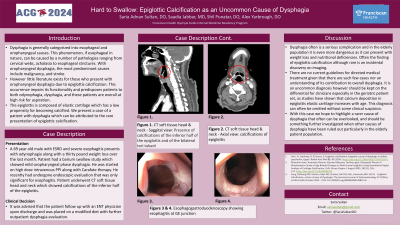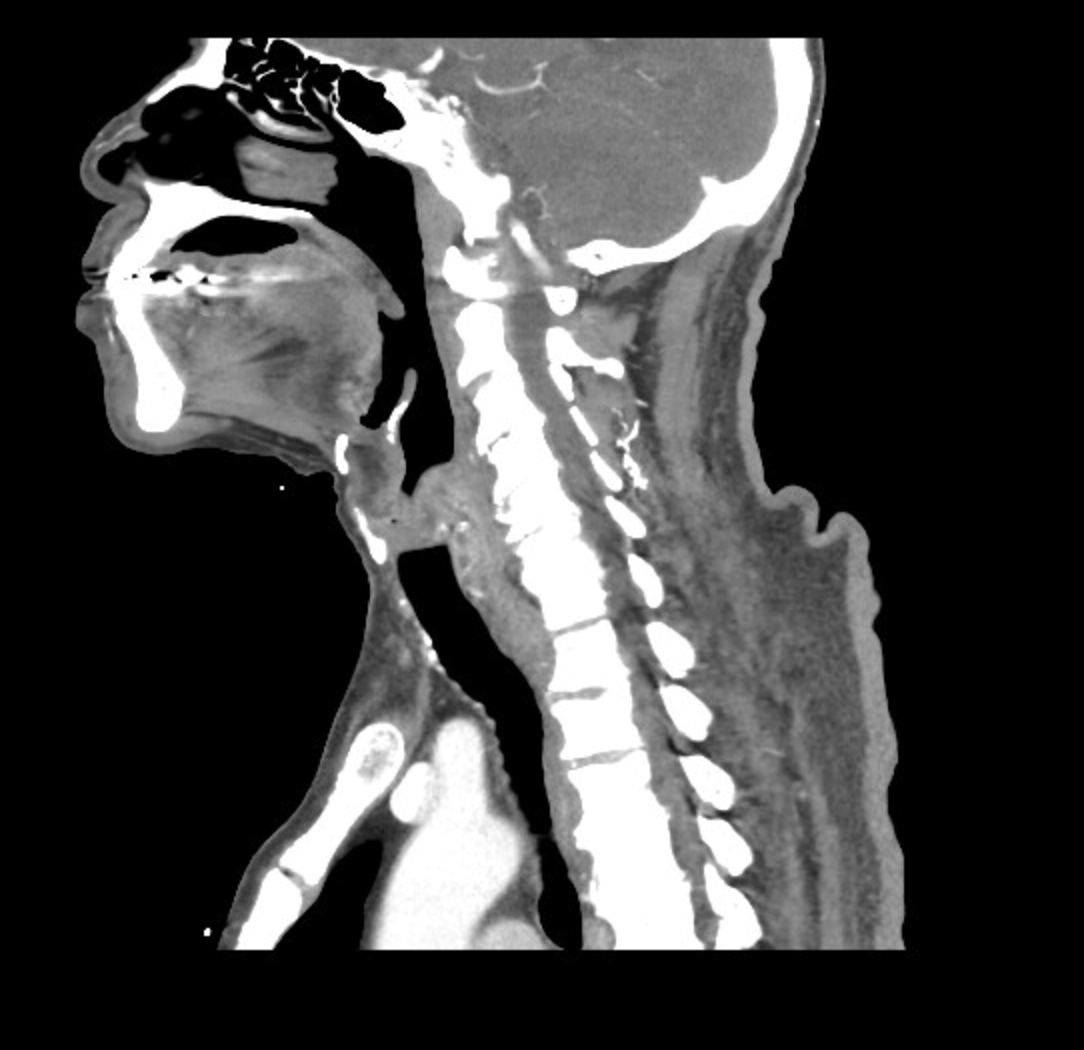Monday Poster Session
Category: Esophagus
P2267 - Hard to Swallow: Epiglottic Calcification as an Uncommon Cause of Dysphagia
Monday, October 28, 2024
10:30 AM - 4:00 PM ET
Location: Exhibit Hall E

Has Audio

Saria Adnan Sultan, DO
Franciscan Health Olympia Fields
Chicago, IL
Presenting Author(s)
Saria Adnan Sultan, DO1, Saadia Jabbar, MD2, Shil Punatar, DO1, Alex Yarbrough, DO1
1Franciscan Health Olympia Fields, Chicago, IL; 2Franciscan Health Olympia Fields, Homewood, IL
Introduction: Dysphagia is generally categorized into esophageal and oropharyngeal causes. This phenomenon, if esophageal in nature, can be caused by a number of pathologies ranging from cervical webs, achalasia to esophageal strictures. With oropharyngeal dysphagia, the most predominant causes include malignancy, and stroke. However little literature exists for those who present with oropharyngeal dysphagia due to epiglottis calcification. This occurrence impairs its functionality and predisposes patients to both odynophagia, dysphagia, and these patients are overall at high risk for aspiration. The epiglottis is composed of elastic cartilage which has a low propensity for becoming calcified. We present a case of a patient with dysphagia which can be attributed to the rare presentation of epiglottic calcification.
Case Description/Methods: A 69 year old male with ESRD and severe esophagitis presents with odynophagia along with a thirty pound weight loss over the last month. Patient had a barium swallow study which showed mild oropharyngeal phase dysphagia. He was started on high dose intravenous PPI along with Carafate therapy. He recently had undergone endoscopic evaluation that was only significant for esophagitis. Patient underwent CT soft tissue head and neck which showed calcifications of the inferior half of the epiglottis. It was advised that the patient follow up with an ENT physician upon discharge and was placed on a modified diet with further outpatient dysphagia evaluation.
Discussion: Dysphagia often is a serious complication and in the elderly population it is even more dangerous as it can present with weight loss and nutritional deficiencies. Often the finding of epiglottic calcification although rare is an incidental discovery on imaging. There are no current guidelines for directed medical treatment given that there are such few cases nor an understanding of its contribution to overall dysphagia. It is an uncommon diagnosis however should be kept on the differential for clinicians especially in the geriatric patient set, as studies have shown that calcium deposition in epiglottis elastic cartilage increases with age. This diagnosis can often be omitted without some clinical suspicion. With this case we hope to highlight a rarer cause of dysphagia that often can be overlooked, and should be something further investigated when other causes of dysphagia have been ruled out particularly in the elderly patient population.

Disclosures:
Saria Adnan Sultan, DO1, Saadia Jabbar, MD2, Shil Punatar, DO1, Alex Yarbrough, DO1. P2267 - Hard to Swallow: Epiglottic Calcification as an Uncommon Cause of Dysphagia, ACG 2024 Annual Scientific Meeting Abstracts. Philadelphia, PA: American College of Gastroenterology.
1Franciscan Health Olympia Fields, Chicago, IL; 2Franciscan Health Olympia Fields, Homewood, IL
Introduction: Dysphagia is generally categorized into esophageal and oropharyngeal causes. This phenomenon, if esophageal in nature, can be caused by a number of pathologies ranging from cervical webs, achalasia to esophageal strictures. With oropharyngeal dysphagia, the most predominant causes include malignancy, and stroke. However little literature exists for those who present with oropharyngeal dysphagia due to epiglottis calcification. This occurrence impairs its functionality and predisposes patients to both odynophagia, dysphagia, and these patients are overall at high risk for aspiration. The epiglottis is composed of elastic cartilage which has a low propensity for becoming calcified. We present a case of a patient with dysphagia which can be attributed to the rare presentation of epiglottic calcification.
Case Description/Methods: A 69 year old male with ESRD and severe esophagitis presents with odynophagia along with a thirty pound weight loss over the last month. Patient had a barium swallow study which showed mild oropharyngeal phase dysphagia. He was started on high dose intravenous PPI along with Carafate therapy. He recently had undergone endoscopic evaluation that was only significant for esophagitis. Patient underwent CT soft tissue head and neck which showed calcifications of the inferior half of the epiglottis. It was advised that the patient follow up with an ENT physician upon discharge and was placed on a modified diet with further outpatient dysphagia evaluation.
Discussion: Dysphagia often is a serious complication and in the elderly population it is even more dangerous as it can present with weight loss and nutritional deficiencies. Often the finding of epiglottic calcification although rare is an incidental discovery on imaging. There are no current guidelines for directed medical treatment given that there are such few cases nor an understanding of its contribution to overall dysphagia. It is an uncommon diagnosis however should be kept on the differential for clinicians especially in the geriatric patient set, as studies have shown that calcium deposition in epiglottis elastic cartilage increases with age. This diagnosis can often be omitted without some clinical suspicion. With this case we hope to highlight a rarer cause of dysphagia that often can be overlooked, and should be something further investigated when other causes of dysphagia have been ruled out particularly in the elderly patient population.

Figure: Figure 1. Presence of calcifications of the inferior half of the epiglottis and of the bilateral tori tubarii
Disclosures:
Saria Adnan Sultan indicated no relevant financial relationships.
Saadia Jabbar indicated no relevant financial relationships.
Shil Punatar indicated no relevant financial relationships.
Alex Yarbrough indicated no relevant financial relationships.
Saria Adnan Sultan, DO1, Saadia Jabbar, MD2, Shil Punatar, DO1, Alex Yarbrough, DO1. P2267 - Hard to Swallow: Epiglottic Calcification as an Uncommon Cause of Dysphagia, ACG 2024 Annual Scientific Meeting Abstracts. Philadelphia, PA: American College of Gastroenterology.
